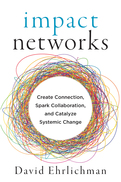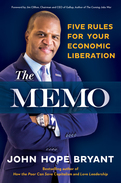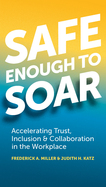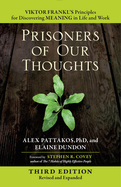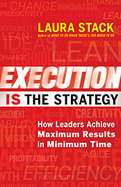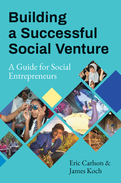2021
The social and environmental challenges we face today are not only complex, they are also systemic and structural and have no obvious solutions. They require diverse combinations of people, organizations, and sectors to coordinate actions and work together even when the way forward is unclear. Even so, collaborative efforts often fail because they attempt to navigate complexity with traditional strategic plans, created by hierarchies that ignore the way people naturally connect.
By embracing a living-systems approach to organizing, impact networks bring people together to build relationships across boundaries; leverage the existing work, skills, and motivations of the group; and make progress amid unpredictable and ever-changing conditions. As a powerful and flexible organizing system that can span regions, organizations, and silos of all kinds, impact networks underlie some of the most impressive and large-scale efforts to create change across the globe.
David Ehrlichman draws on his experience as a network builder; interviews with dozens of network leaders; and insights from the fields of network science, community building, and systems thinking to provide a clear process for creating and developing impact networks. Given the increasing complexity of our society and the issues we face, our ability to form, grow, and work through networks has never been more essential.
2017
Building on his personal experience of rising up from economically disadvantaged circumstances and his work with Operation HOPE, Bryant teaches readers five rules that lay the foundation for achieving financial freedom. He emphasizes the inseparable connection between “inner capital” (mindset, relationships, knowledge, and spirit) and “outer capital” (financial wealth and property). “If you have inner capital,” Bryant writes, “you can never be truly poor. If you lack inner capital, all the money in the world cannot set you free.”
Bryant gives readers tools for empowerment by covering everything from achieving basic financial literacy to investing in positive relationships and approaching wealth with a completely new attitude. He makes this bold and controversial claim: “Once you have satisfied your basic sustenance needs—food, water, health, and a roof over your head—poverty has more to do with your head than your wallet.”
Bryant wants to restore readers' “silver rights,” giving them the ability to succeed and prosper no matter what very real roadblocks society puts in their way. We have more power than we realize, if only we can recognize and claim it. “We are our first capital,” Bryant writes. “We are the CEOs of our own lives.”
2018
Interaction safety encourages reasonable risk-taking and inspires every individual to be brave enough to reach for higher goals and more ambitious possibilities. When interaction safety exists, people know they will not be penalized, ostracized, demoted, made small, discounted, or shunned because of their thoughts, contributions, and conversations. Individuals feel encouraged, empowered, and can achieve more together than they would alone.
Miller and Katz provide a four-level model for assessing and increasing the interaction safety in organizations, illustrated by short scenarios taken from real-life situations. They offer concrete actions team members, leaders, and organizations can take to build and maintain a productive, collaborative, and innovative environment in which people do their best work individually and collectively.
When interaction safety is a way of life, the energy people used to spend walking on eggshells, trying to get their ideas heard, navigating minefields, or avoiding those they distrust can instead be put towards doing their best work and winning bigger for the organization. With a culture of openness and true collaboration, both the organization and individuals can soar!
World-renowned psychiatrist Viktor Frankl's Man's Search for Meaning is one of the most important books of modern times. Frankl's extraordinary personal story of finding meaning amid the horrors of the Nazi concentration camps has inspired millions. Frankl vividly showed that you always have the ultimate freedom to choose your attitude—you don't have to be a prisoner of your thoughts.
Dr. Alex Pattakos—who was urged by Frankl to write Prisoners of Our Thoughts—and Elaine Dundon, a personal and organizational innovation thought leader, show how Frankl's wisdom can help readers find meaning in every moment of their lives. Drawing on the entire body of Frankl's work, they identify seven “core principles” and demonstrate how they can be applied to everyday life and work.
This revised and expanded third edition features new stories, practical exercises, applications, and insights from the authors' new work in MEANINGology®. Three new chapters outline how we all can benefit by putting meaning at the core of our lives, work, and society. And a new chapter on Viktor Frankl's legacy illustrates how his work continues to influence so many around the world.
Shows how strategy and tactics are part of the same overarching process, requiring greater flexibility and more rapid implementation than ever before.
- Shows how strategy and tactics are part of the same overarching process, requiring greater flexibility and more rapid implementation than ever before
- Reveals how to create agile and resilient organizations, where execution continually modifies and adjusts the strategy to fit current realities
- Includes the "Execution Quotient" leadership assessment and access to an online group reading guide and self-development resources
Once upon a time, executives would go to an off-site brainstorming session, come back with a multiyear strategic plan, and hand it off to their employees to dutifully execute. But in today's world of rapid, disruptive change, it's hard enough to come up with a five-month plan, let alone a five-year plan. As one executive interviewed by author Laura Stack put it, "You prepare a strategic plan and then put it on the shelf while the real world passes you by."
Nowadays, strategy can't be separate from execution-it has to emerge from execution. New technologies, sudden changes in global markets, and viral customer reactions to new products require quick, nimble responses-sometimes even a complete strategic 180. But if your organization isn't set up to be fast on its feet, you could easily go the way of Blockbuster or Borders.
Stack shows you how to make sure your organization is ready for on-the-spot strategic execution. Her LEAD formula explains how to Leverage the people and resources you need to create an agile organization, establish an Environment where your employees are confident and capable enough to take the initiative and make on-the-fly changes, ensure that your team is in Alignment with the organization's goals so they'll make the right strategic choices, and remove obstacles so they can Drive the organization forward quickly.
Of course, you'll still need to have a great strategy in place, but your goals must be subject to constant readjustment and revision. You have to work with your team to build effective business strategies in real time, not be bound by a plan that may be out of date as soon as it rolls off the printer. Execution really is the strategy that will propel your organization forward, and Laura Stack can help you build an organization ready to meet the challenge of constant change.
Building a Successful Social Venture draws on Eric Carlson's and James Koch's pioneering work with the Global Social Benefit Institute, cofounded by Koch at Santa Clara University's Miller Center for Social Entrepreneurship. Since 2003, over 200 Silicon Valley executives have mentored more than 800 aspiring social entrepreneurs at the GSBI. It is this unparalleled real-world foundation that truly sets the book apart. Early versions of the book were used in both undergraduate and MBA classes.
Part 1 of the book describes the assumptions that the GSBI model is based on: a bottom-up approach to social change, a focus on base-of-the-pyramid markets, and a specific approach to business planning developed by the GSBI. Part 2 presents the seven elements of the GSBI business planning process, and Part 3 lays out the keys to executing it. The book includes “Social Venture Snapshots” illustrating how different organizations have realized elements of the plan, as well as a wealth of checklists and exercises.
Social ventures hold enormous promise to solve some of the world's most intractable problems. This book offers a tested framework for students, social entrepreneurs, and field researchers who wish to learn more about the application of business principles and theories of change for advancing social progress and creating a more just world.


